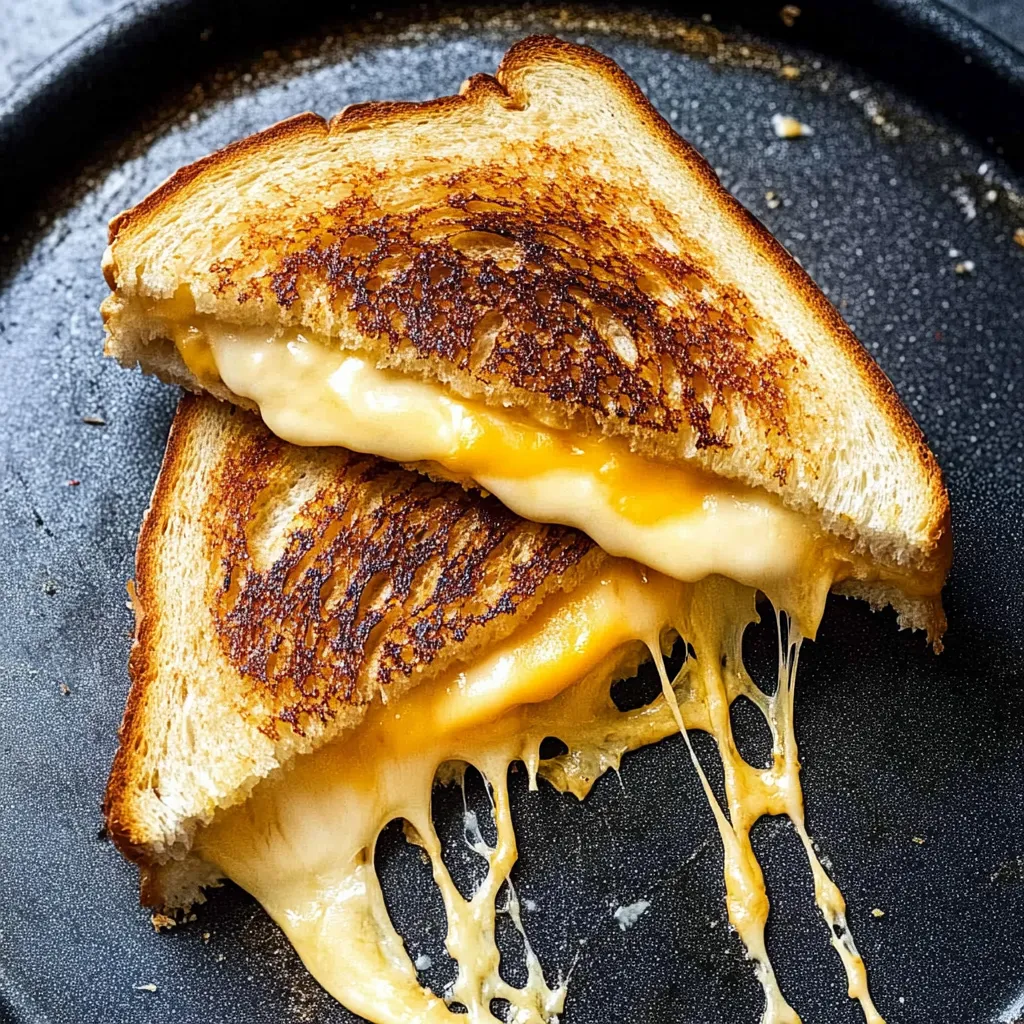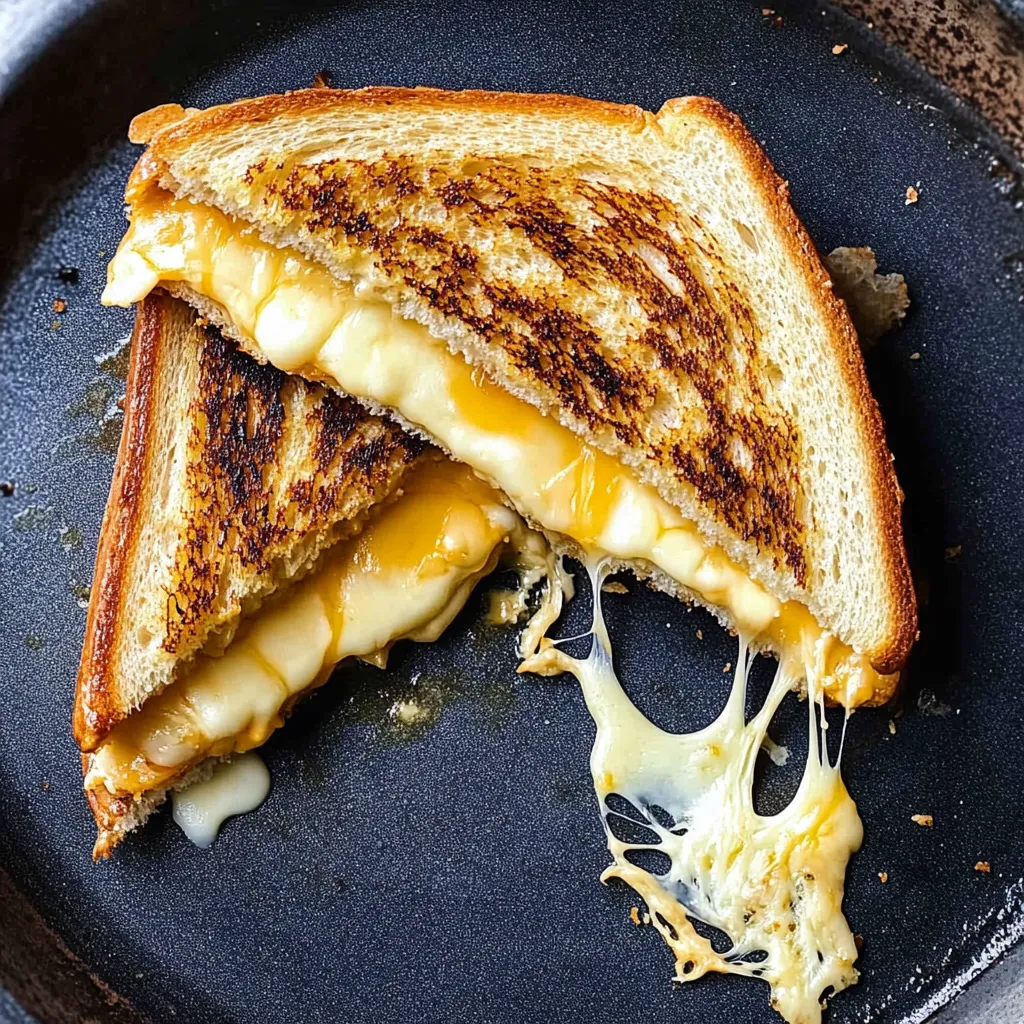 Pin it
Pin it
Spreading mayonnaise on the outside of the bread instead of butter creates grilled cheese sandwiches with impossibly crisp, golden-brown exteriors and perfectly melted cheese centers. Cooking low and slow with the pan covered traps steam that melts the cheese evenly while the bread toasts to crunchy perfection. Combining sharp cheddar with Gruyère or raclette adds complexity beyond basic American cheese, and grating rather than slicing ensures even melting throughout. This technique transforms simple ingredients into grilled cheese that rivals any restaurant version.
Grilled cheese seemed straightforward until realizing that small technique changes create dramatically different results. The first time I spread mayo on the outside instead of butter, I was skeptical - it seemed wrong. But tasting the incredibly crisp, evenly golden bread changed my mind completely. Learning to cover the pan while cooking was another revelation - the trapped steam melts the cheese thoroughly while the bread toasts. Now this method is the only way I make grilled cheese because it consistently delivers restaurant-quality results.
Ingredients and Why They Matter
- Sourdough bread (2 slices, ½-inch thick): Tang complements cheese perfectly; white bread works too
- Mayonnaise (1-2 tablespoons): Spread on outside of bread for superior browning; not inside
- Dijon mustard (1 teaspoon): Spread on inside for subtle tangy depth; not traditional but delicious
- Unsalted butter (1 tablespoon): For coating the pan, not the bread
- Sharp cheddar cheese (1-2 ounces, grated): Essential nutty, sharp flavor that melts beautifully
- Gruyère or raclette cheese (1-2 ounces, grated): Adds complexity and incredible melt; Swiss-style Alpine cheese
Cheese Alternatives:
- Any good melter: mozzarella, fontina, gouda, Monterey Jack, pepper jack, havarti
- For extra funk: add blue cheese
- For creaminess: add brie
How To Make It
- Prep the bread:
- Lay out two slices of sourdough or white bread on your work surface. Spread mayonnaise on the outside (one side only) of each slice - this is the side that will touch the pan. Use about ½ tablespoon mayo per slice, spreading it evenly from edge to edge like you would butter. On the inside of one slice only, spread about 1 teaspoon Dijon mustard thinly across the surface. The mustard adds subtle tang that elevates the sandwich beyond basic grilled cheese.
- Grate and assemble the cheese:
- Using the large holes on a box grater, grate about 1-2 ounces each of sharp cheddar and Gruyère or raclette. Grating rather than slicing is crucial - grated cheese melts more evenly and completely than sliced cheese which can have cold, unmelted spots. Pile all the grated cheese onto the mustard-spread slice of bread, creating a generous mound. The cheese should cover the bread completely and mound up slightly in the center. Place the other slice of bread on top, mayo side facing out, and press down gently.
- Heat the pan properly:
- Place a cast-iron skillet or nonstick pan over medium-low heat. Let it preheat for 2-3 minutes until warm but not smoking hot. This low temperature is essential - too high and the bread burns before the cheese melts. Add the butter to the pan and swirl to coat the entire bottom surface as it melts. The butter should sizzle gently but not brown immediately.
- Cook the first side covered:
- Carefully place the assembled sandwich in the buttered pan. Immediately cover the skillet with a lid. This is the secret step most people skip - the lid traps steam that melts the cheese from the inside while the bread toasts from the outside. Cook for 2-3 minutes without moving the sandwich. Resist the urge to peek constantly - lifting the lid releases the steam. After 2-3 minutes, lift the sandwich with a spatula to check the bottom. It should be deep golden brown and crispy. If it's browning too quickly, reduce the heat. If too pale after 3 minutes, increase heat slightly and give it another minute.
- Flip and finish:
- Once the bottom is perfectly golden, use a wide spatula to carefully flip the sandwich. Cover the pan again with the lid and cook the second side for another 2-3 minutes until equally golden brown and crispy. The cheese should be completely melted at this point - you might see it starting to ooze slightly from the edges, which is perfect. If the cheese isn't fully melted but the bread is browning, reduce heat to low and cook another minute or two covered.
- Serve immediately:
- Remove the sandwich from the pan and transfer to a cutting board. Let it rest for just 30 seconds - this allows the cheese to set slightly so it doesn't all run out when you cut it. Use a sharp knife to cut the sandwich diagonally into two triangles. Serve immediately while the bread is still crispy and the cheese is molten. The sandwich tastes best eaten right away. Serve with tomato soup for dipping if desired.
 Pin it
Pin it
Mayo versus butter on the outside confused me until understanding the science. Mayonnaise is an emulsion of oil and eggs, which browns more evenly and at lower temperatures than pure butter. The emulsifiers help create uniform golden color rather than splotchy browning. Mayo also contains more fat than butter - butter is about 80% fat while mayo is closer to 80% oil - so it adds more richness. The result is bread that's crispier and more uniformly golden than butter-spread bread.
Why Mayo Works Better Than Butter
Butter seems like the obvious choice for grilled cheese, but mayo creates superior results for several reasons. Butter contains water (about 15-20%) that can make bread soggy before it crisps. Mayo is nearly all fat, so it creates immediate crisping without any steaming phase. Butter also burns at lower temperatures than mayo - butter's milk solids scorch easily while mayo's oil-based composition tolerates the heat better. The end result is bread that's crispier, more evenly golden, and richer-tasting.
The Covered Pan Technique
Covering the pan while cooking might seem unnecessary, but it's the difference between good and great grilled cheese. The lid traps steam inside the pan, creating a mini-oven environment. This steam heats the cheese from above while the pan heats the bread from below, ensuring the cheese melts completely at the same time the bread browns. Without the lid, you often get burnt bread with cold, unmelted cheese in the center. The steam is especially important with thick artisan breads and multiple types of cheese.
Low and Slow Cooking
Patience is essential for perfect grilled cheese. Medium-low heat gives the cheese time to melt thoroughly before the bread burns. If you cook on medium-high, the outside gets dark and crispy while the inside stays cold. It's better to cook a few minutes longer at lower heat than to rush with high heat. Watch the sandwich carefully - if it's browning too fast, reduce heat immediately. Every stovetop is different, so adjust based on your results.
Cheese Selection Strategy
Using two different cheeses creates more interesting, complex flavor than single-cheese sandwiches. Sharp cheddar provides familiar, comforting taste with excellent melting properties. Gruyère or raclette adds sophistication - these Alpine-style cheeses have nutty, slightly funky flavors that elevate the sandwich beyond childhood nostalgia. The combination tastes grown-up while remaining recognizable as grilled cheese. Other great melters include fontina, gouda, Monterey Jack, or mozzarella.
Grating vs Slicing Cheese
This small detail makes significant difference in final texture. Grated cheese has much more surface area than sliced cheese, allowing it to melt faster and more uniformly. The small shreds melt together into cohesive, gooey filling without any unmelted chunks. Sliced cheese, especially thick slices, often has cold spots that never fully melt. For softer cheeses like brie that can't be grated, slice them as thinly as possible for best melting.
Bread Selection
Sourdough provides tangy flavor that complements rich cheese beautifully. The slight acidity cuts through the fat and adds complexity. The sturdy texture holds up well during cooking without becoming soggy. White sandwich bread creates classic, nostalgic grilled cheese with softer texture. Avoid very thick artisan breads over ¾-inch thick - the outside burns before the inside heats through. Sliced bread from the bakery or grocery bakery section works perfectly.
Variations and Add-Ins
While classic grilled cheese is perfect, additions create endless variations. Sautéed spinach or caramelized onions add vegetables. Roasted red peppers provide sweetness. Thinly sliced apples with brie and Gruyère create sophisticated French-inspired version. Bacon or prosciutto adds savory depth. Pickled jalapeños provide heat and acidity. Fig jam creates sweet-savory contrast. Pesto replaces the mustard for herby flavor. Add ingredients sparingly so the sandwich doesn't become overstuffed and fall apart.
 Pin it
Pin it
This grilled cheese sandwich represents the kind of recipe that proves mastering fundamentals creates better results than complicated techniques. The combination of crispy, golden bread and perfectly melted cheese creates comfort food satisfaction that never gets old. When you bite into a sandwich with that perfect cheese pull and hear the crunch of crispy bread, you know you've created something that might be simple but is absolutely perfect. Sometimes the best recipes are the ones that elevate everyday classics through better technique, and this grilled cheese definitely accomplishes that goal perfectly every single time you make it.
Frequently Asked Questions
- → What's the best bread for grilled cheese?
- Sourdough works great because it gets nice and crispy. You can also use white bread, whole wheat, or any sturdy bread you like.
- → Can I use different cheese?
- Yes! Try mozzarella, fontina, provolone, or even American cheese. Mixing two types of cheese gives you the best flavor and texture.
- → Why use mayo instead of butter on the bread?
- Mayo spreads easier and helps the bread brown evenly. It creates a crispy, golden crust without burning as quickly as butter can.
- → How do I keep the cheese from burning before it melts?
- Cook on medium-low heat and cover the pan. This traps heat to melt the cheese while the bread browns slowly. Lower the heat if needed.
- → Can I make this without mayo?
- Sure! Just butter the outside of the bread instead. Both methods work well, so use whatever you prefer or have on hand.
- → What goes well with grilled cheese?
- Tomato soup is the classic pairing. Also try pickles, chips, a simple salad, or fresh fruit on the side.
